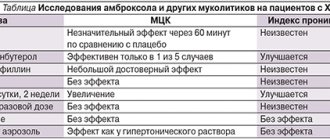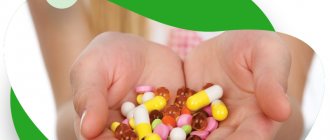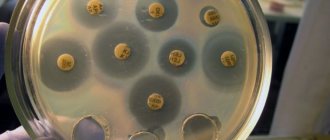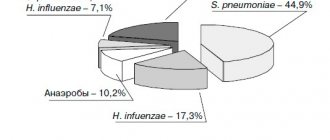Author:
- Elena Vitalievna Naumova, otolaryngologist, leading doctor of the clinic
2.83 (Votes: 12)
If the temperature exceeds 38°C, the lymph nodes are inflamed, white plaque has spread to the tonsils, the back wall of the pharynx, then antimicrobial therapy cannot be avoided. To prevent purulent tonsillitis from developing into a chronic process, taking antibacterial drugs is mandatory. Medicines suppress the growth of bacteria, prevent infection of family members, and reduce the likelihood of complications.
Only an ENT doctor can figure out which antibiotic is effective and safe for purulent sore throat.
Main groups of drugs
Sore throat is provoked by different types of opportunistic microorganisms and treatment depends on the specific causative agent of the disease. First of all, the ENT doctor will give a referral for a blood test and bacterial culture from the tonsils to detect antibiotic resistance.
Most often, purulent tonsillitis is treated with systemic antibiotics:
- Penicillin series. They have fewer contraindications, so they are often prescribed to children and adults with intolerance to other groups of antibiotics. Penicillins are effective only at the initial stage, when ulcers have not formed. It is worth noting that they are not prescribed if the patient has a history of bronchial asthma or urticaria. During pregnancy, they are prescribed only when absolutely necessary in the early stages.
- Cephalosporins. They are beneficial in severe cases of the disease. They are low toxic and effective from the first day of use. Can be prescribed to pregnant women.
- Macrolides. Prescribed if there is no effect from taking medications of the first two groups. Macrolides have an extended list of contraindications and are taken in a short course. It is worth noting that they are prohibited during pregnancy and breastfeeding.
- Lincosamides. Used for frequent exacerbations of purulent tonsillitis.
General therapy should be comprehensive, i.e. It is possible to speed up recovery and remove the pathogen with oral antibiotics and local treatment. Local antibiotics for purulent sore throat are prescribed to young children and pregnant women.
Consequences of purulent sore throat
Acute tonsillitis can occur with complications. They are usually divided into local and general.
Local complications:
- paratonsillar abscess - an abscess that forms outside the tonsil when infection penetrates into the surrounding tissue;
- acute otitis media – inflammation of the middle ear;
- acute laryngitis - inflammation of the larynx;
- cervical lymphadenitis – inflammation of the lymph nodes1.
General complications occur more often with streptococcal sore throat4, these include:
- rheumatism;
- rheumatoid arthritis;
- myocarditis;
- polyarthritis;
- glomerulonephritis and pyelonephritis;
- pneumonia and others1.
Up to contents
Reception features
Each antibacterial drug is taken differently. The dosage, regimen, and duration of therapy are selected by the ENT doctor individually for each patient. Penicillins are usually eliminated from the body quickly, so treatment with drugs of this group involves frequent taking of tablets. Cephalosporins in tablet form are taken every 6-12 hours.
Uncontrolled use of antibiotics entails a decrease in the sensitivity of bacteria to the drug and a lack of treatment effect, and subsequently to the development of persistent resistance of the patient's microflora to antibacterial drugs.
Antimicrobial agents are taken one hour before meals or two hours after meals. Thus, the absorption of the active substance is higher.
Precautions during therapy
When using antibiotics to treat diseases of the ENT organs, a number of rules must be followed. They will allow you to protect your body as much as possible from the negative effects of the drug. If they are ignored, then treatment for side effects will be required in the future, which is quite lengthy and complex.
The main danger when using antibiotics is the development of dysbiosis, which can be very severe. To prevent this phenomenon, the use of probiotics is prescribed in parallel with the drug. They will restore the correct balance of beneficial bacteria and maintain intestinal health.
Release form
Depending on the stage of development of the disease, the ENT doctor prescribes different types of antibiotics:
- Tablets and syrups. Used as the disease progresses. Usually the drug effect is noticeable 2-4 days after the start of administration.
- Local medications (sprays, lozenges). They are used as an addition to the main therapy, since they only relieve acute pain when swallowing saliva, and do not kill completely pathogenic bacteria.
- Injections for intramuscular and intravenous administration are prescribed for advanced stages of angina, when the patient cannot swallow a tablet. Basically, antibiotics of the bicillin group are used as active substances once. The effectiveness of injections is much higher, since the active substance is evenly distributed throughout the tissues. A high concentration of the drug lasts longer, so the result is visible faster.
Important to remember! The earlier the diagnosis is made and rational therapy for acute purulent tonsillitis is prescribed, the greater the chances of curing the disease without developing serious complications. At the first manifestations of purulent tonsillitis, do not waste precious time self-medicating, consult a doctor! This will save you and your loved ones from serious consequences!
Hexoral against purulent sore throat
For acute tonsillitis, all drugs from the HEXORAL® line can be used.
You can treat the throat with a sore throat (acute tonsillitis) using HEXORAL® spray based on hexethidine. It allows you to evenly cover the surface of the mucous membrane of the tonsils and pharynx, which contributes to a more effective fight against infection8. A solution of HEXORAL® with hexethidine and a combination of essential oils7 may be suitable for gargling.
The use of hexetidine preparations is prescribed in clinical guidelines for the treatment of acute tonsillopharyngitis2. Hexetidine is an antiseptic that is active against most bacteria, herpes simplex viruses type 1, influenza A, PC virus that affects the respiratory tract, and fungi. In addition, it has a mild analgesic effect7.
Both HEXORAL® spray and solution are approved for use for local treatment of tonsillitis in adults and children over three years of age7,8.
Lozenges with a neutral mint flavor HEXORAL® TABS based on chlorhexidine and benzocaine have antiseptic properties and analgesic properties. They are approved for use in adults and children aged 4 years and older9.
For adults and children over 6 years old, HEXORAL® TABS CLASSIC is available with the flavors of orange, black currant, lemon and honey. It is based on a combination of the antiseptics amylmetacresol and dichlorobenzyl alcohol, which help in the fight against tonsillitis pathogens10.
HEXORAL® TABS EXTRA may be suitable for children over 12 years of age and adults. In addition to the antiseptic component, it contains lidocaine, which can relieve even severe sore throat11.
The information in this article is for reference only and does not replace professional advice from a doctor. To make a diagnosis and prescribe treatment, consult a qualified specialist.
Up to contents
Literature
- Dergachev V. S. Angina. Clinic, diagnosis and treatment algorithm. Choice of local antibacterial therapy // Regular issues of “RMZh” / No. 18. – 2007. – P. 1350.
- Clinical recommendations Acute tonsillopharyngitis // National Medical Association of Otorhinolaryngologists / 2016.
- Kunelskaya N.L., Turovsky A.B., Kudryavtseva Yu.S. Sore throats: diagnosis and treatment // General Medicine / No. 3. – 2010. – P. 4-9.
- Krasnova E.I., Khokhlova N.I. Differential diagnosis and treatment tactics for acute tonsillitis (tonsillitis) at the present stage // Attending physician / No. 11. – 2021. – P. 58-63.
- Shcherbakova M. Yu., Belov B. S. A-streptococcal tonsillitis: modern aspects // Pediatrics / Volume 88. - No. 5. – 2009. – P. 127-135.
- Instructions for use of the drug HEXORAL® solution // Reg. number P N014010/02 //
- Instructions for use of the drug HEXORAL® aerosol // Reg. number P N014010/01 //
- Instructions for use of the drug HEXORAL® TABS // Reg. number LSR-002626/07 //
- Instructions for use of the drug HEXORAL® TABS CLASSIC // Reg. number P N015976/01 //
- Instructions for use of the drug HEXORAL® TABS EXTRA // Reg. number LSR-004122/09 //
Up to contents
Prevention
By paying attention to preventive measures, you can reduce the risk of developing the disease. Effective prevention includes:
- avoiding hypothermia (wearing warm clothes, monitoring microclimatic indicators in the room);
- regular preventative visits to the dentist to identify the early stages of caries and stomatitis;
- giving up bad habits (smoking, drinking alcohol);
- moderate physical activity, regular walks in the fresh air;
- normalization of diet, sleep and wakefulness;
- compliance with hygiene standards and requirements, maintaining cleanliness in the home and workplace;
- limiting contacts with unfamiliar people during periods of unfavorable epidemiological conditions.
Strengthening the immune system based on leading a healthy lifestyle helps to avoid infection and make it easier to endure purulent sore throat.
If you have a sore throat, call us and we will definitely help you!
Description of the disease
Follicular tonsillitis is a moderately severe variant of tonsillitis that can affect both infants and adolescents 15-18 years old.
Boys and girls are equally susceptible to pathology. According to statistics, this disease occurs in 8-15% of children. The disease is characterized by acute development, but with timely consultation with a doctor, it is accompanied by complete recovery in 90-92% of cases. The danger of the disease lies in possible complications:
- Acute rheumatic fever. When the cardiovascular system is damaged, the valve apparatus of the heart suffers. Acquired defects develop, which, if left untreated, change first the intracardiac and then the systemic hemodynamics of the patient.
- Formation of peritonsillar abscesses. In the area of the palatine tonsils, ulcers of different sizes form, which are a source of infection and can cause pathogenic bacteria to penetrate into the membranes of the brain (with the bloodstream).
- Infectious arthritis. Bacteria from the palatine tonsils penetrate into the joint cavity through the vascular bed. There they create foci of local inflammation, cause pain, and reduce the child’s range of free movements.
- Nephritis. Kidney damage is an uncommon complication (up to 6-7% of cases). It is characterized by the formation of a focus of chronic infection in the kidneys, which cannot always be completely eliminated.
When microorganisms penetrate the membranes of the child’s brain, meningitis develops.
The disease directly threatens the patient's life and requires hospitalization in the intensive care unit. Therefore, each episode of follicular tonsillitis should be under the supervision of a doctor. A child does not always need hospitalization. However, it is important for a specialist to assess the condition and determine further therapeutic tactics.
Stages of disease development
The disease progresses rapidly. This is especially true in children and adults with a weakened immune response. Symptoms depend on the current state of the body, age, concomitant diseases and the stage of infectious tissue damage.
Signs of the development of the disease at different stages from the moment of infection:
- 2-3 days.
This stage is characterized by the maximum severity of the symptomatic picture. The patient's tonsils increase significantly in size and white or yellowish ulcers appear on their surface. The inflammatory process covers the entire surface of the tonsils. The patient notes deterioration in health, weakness, loss of appetite and signs of fever, including an increase in body temperature to 39-40 ° C. The patient also experiences excruciating pain in the throat, which gets worse when swallowing. - Day 4
The ulcers that form on the tonsils begin to spontaneously open, releasing the contents (pus). In their place, lacunae are formed - characteristic depressions. If at this stage the patient follows the doctor’s recommendations, the lacunae quickly close. - 5-6 day
. At this stage, patients feel a noticeable improvement in their condition - body temperature normalizes, headaches go away, strength and appetite are restored. - 7-10 day
. The last pathological sign – sore throat – recedes. The size of the lymph nodes located under the lower jaw also decreases. The patient ceases to feel pain and discomfort in this area.
Competent and timely therapy allows you to avoid serious complications.










